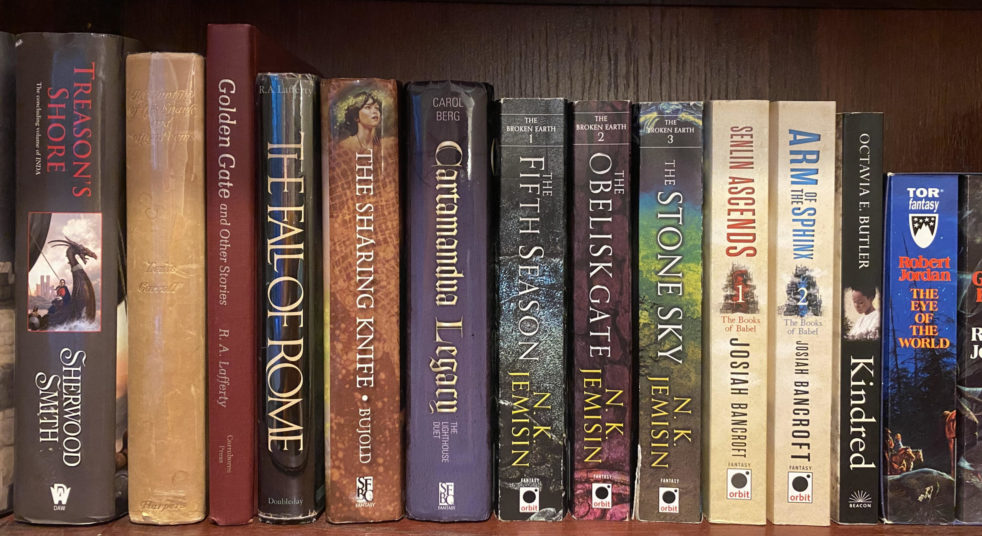
I didn’t know that Mechanize My Hands to War even existed until author Erin K. Wagner was interviewed in Clarkesworld in December 2024. But as so often happens with Clarkesworld interviews, she talked about it in a way that caught my attention and sent it flying up my TBR. And I’m glad it did.
Mechanize My Hands to War takes place almost entirely in the relatively near future in rural Appalachia. Pollution has crippled farms, and automation has precipitated a flurry of layoffs in factories. An anti-android militia has recruited the jobless and orphans to fight to return the United States to the country they remember, and the Bureau of Alcohol, Tobacco, and Firearms is beginning to use combat-ready androids alongside its human agents trying to put down the threat. And Mechanize My Hands to War shows the reader all of it. In addition to a brief prologue and epilogue, the book’s ten sections follow eight different characters or character pairs, with each section consisting of four subchapters that jump back and forth in time, building each character out of a handful of carefully chosen vignettes, and telling the core story from truly every angle.
The first thing that jumps out about Mechanize My Hands to War is its remarkable groundedness. One of its main projects is using a speculative premise to explore politics and society—if there’s any major player who isn’t thoroughly humanized, it’s the megacorporation cutting financial costs without heed for the human cost—but unlike other novels that create black-and-white divides between cartoonish villains and glorious rebels, Mechanize My Hands to War delivers a portrait of the future that’s terrifying in its plausibility, with characters who could walk right off the page and into the woods. But its refusal to hand readers pat solutions does not lessen the thematic impact one bit, instead creating layers upon layers of depth underneath a powerful premise. There are times those layers are discouraging, but they always feel real. This line absolutely doesn’t represent every character, but it certainly reflects the background mood:
No one here really believes in anything, honey. We just get drunk and do stupid things. It’s all there’s left to do.
And a huge part of that is the quality of the characterization. There are eight distinct point-of-view sections, with most characters getting no more than 30 pages of perspective, but it does a remarkable job bringing those characters to life in that span. The two military android perspective characters don’t feel quite as strong as the rest, giving the feeling that the story was caught between humanizing them and highlighting their inhumanity, but it quickly regains that balance when the perspective shifts to a pair of non-military androids. And if the android perspectives are a hair uneven, the story more than makes up for it with the quality of the human characters. We see law enforcement and terrorists, ailing farmers and disillusioned children, and they all bear the indelible stamp of reality. In 20 or 30 pages each, the novel builds horrible trauma, heartrending tragedies, or difficult paths forward, with every single one crafted to bring the reader into the very middle of the struggle.
But for all that it’s structured as a mosaic, Mechanize My Hands to War has enough plot structure to give it a sense of momentum. It may not necessarily be forward momentum, but rather a rotational one, orbiting around a major event and getting closer with every pass. The dominant story is of the conflict between the militia and the ATF—both the humans and the androids—with a strong subplot about an ailing farmer couple employing a caretaker android as they try to hold onto the last vestiges of their life they once lived. With every new perspective character, the reader sees another piece of the climactic events, until finally the closing chapters lock the pieces firmly into place. The conceit may frustrate readers who want to drive forward to the new rather than seeing the old in a different light, but for a novel so interested in the perspectives of everyday people (and sentient androids) on major events, the revisiting of the story’s biggest scenes seems a perfect narrative fit. And those big events were certainly compelling enough to keep me invested in converting those first glimpses into a complete picture.
I really don’t have many complaints here. I’d have liked to see the prologue and epilogue connected a little more tightly to the plot (they are perfectly well connected to the themes), and one or two of the eight perspectives weren’t quite as strong, but those are small potatoes in the grand scheme of things. Mechanize My Hands to War is a careful, grounded, deeply human near-future sci-fi, with a compelling plot, characters that feel like they could walk off the page, and thematic work that shines a grim light on our world through a view of what could be, all the while still offering a glimmer of hope that things can always be improved. It’s an excellent book that deserves more attention.
Recommended if you like: mosaic stories, near-future sci-fi, grounded themes.
Can I use it for Bingo? It’s hard mode for Dreams, Prologues and Epilogues, Multi-POV, Character with a Disability, and Published in 2024.
Overall rating: 17 of Tar Vol’s 20. Five stars on Goodreads.
